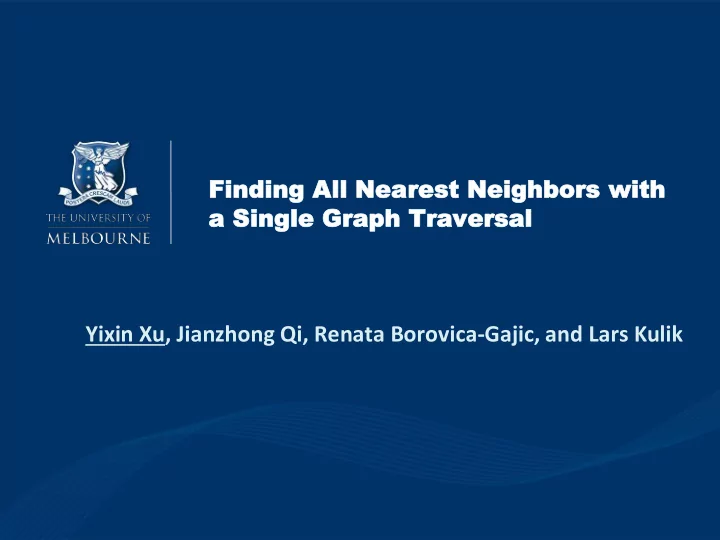

Finding Finding Al All l Nearest earest Neighb Neighbors ors wi with th a Single a Single Graph Traversal raph Traversal Yixin Xu, Jianzhong Qi, Renata Borovica-Gajic, and Lars Kulik
Motivation Parking undersupply? 65% oversupply [1] https://www.eveningtelegraph.co.uk/fp/park-ride-scheme-considered-ease-parking-dundees-ninewells-hospital/ [2] http://nelsonnygaard.com/publication/parking-in-mixed-use-districts/ [3] http://www.global.datafest.net/projects/smart-parking-imt
Problem definition • Find the nearest parking space for every driver Efficient & scalable All Nearest Neighbour (ANN) algorithm • Example : Query objects 1 14 Data objects
Problem definition • Find the nearest parking space for every driver Efficient & scalable All Nearest Neighbour (ANN) algorithm • Example : Query objects 8 Data objects 15
Problem definition • Find the nearest parking space for every driver Efficient & scalable All Nearest Neighbour (ANN) algorithm • Example: Query objects Data objects
Literature review • ANN algorithms in Euclidean space cannot be applied Euclidean distance Network distance VIVET the first study on ANN problem in spatial networks
Existing NN algorithms comparison INE G-tree ROAD IER-PHL DisBrw Query time 5 th 2 nd 3 rd 1 st 3 rd Precomputation 1 st 3 rd 2 nd 4 th 5 th time Precomputation 1 st 2 nd 3 rd 4 th 5 th memory State-of-the-arts: IER-PHL, G-tree, INE [4] Abeywickrama, T., Cheema, M.A., Taniar, D.: K-nearest neighbors on road networks: a journey in experimentation and in-memory implementation. PVLDB 9(6), 492 – 503 (2016)
Limitation of NN algorithms • Large memory cost, not scalable to large networks US road network (23.9 million vertices) IER-PHL G-tree VIVET Memory >64 GB 2.4 GB 182.7MB • Multiple visit to the same areas, not efficient for large query sets q i q j Multiple visit area
VIVET overview • Precomputation phase – Traverse the graph only once – Short precomputation time – Low memory size • Query phase – Answer a NN query in constant time – Answer an ANN query in linear time
Precomputation phase • Precomputation algorithm – Step 1, add a virtual vertex v * – Step 2, connect v * with all data objects with weight zero – Step 3, traverse the road network from the virtual vertex (Dijkstra’s algorithm) • Example v * 0 0
Precomputation phase • Get NN( v i ) from SP( v * , v i ) – SP( v * , v i ) must traverse exactly one data object – The traversed object is the nearest neighbour (NN) of v i • Example SP( v * , v 11 ) = { v * , o 2 , v 10, v 11 } NN ( v 11 ) =o 2
The Index of VIVET • VIVET index v 1 v 2 v 3 v 4 v 5 v 6 v 7 v 8 v 9 v 10 v 11 v 12 v 13 NN o 1 o 1 o 1 o 1 o 1 o 1 o 2 o 1 o 2 o 2 o 2 o 2 o 2 distance 1 2 5 0 2 6 6 8 0 5 8 10 9 Memory: linear to the number of vertices
Query phase • Query algorithm v 1 v 2 v 3 v 4 v 5 v 6 v 7 v 8 v 9 v 10 v 11 v 12 v 13 NN o 1 o 1 o 1 o 1 o 1 o 1 o 2 o 1 o 2 o 2 o 2 o 2 o 2 distance 1 2 5 0 2 6 6 8 0 5 8 10 9
Experiments • Datasets – Road network: 9th DIMACS Implementation Challenge [5] – Real-world data objects from OpenStreetMap [4] – Synthetic objects • Implementation – C++ – 64-bit virtual node with 1.8GHz GPU and 64GB RAM from Nectar [6] [4] Abeywickrama, T., Cheema, M.A., Taniar, D.: K-nearest neighbors on road networks: a journey in experimentation and in-memory implementation. PVLDB 9(6), 492 – 503 (2016) [5] http://www.dis.uniroma1.it/challenge9/download.shtml [6] https://nectar.org.au
Precomputation performance • Precomputation memory – Vary the road network size VIVET reduces the memory consumption by one order of magnitude
Precomputation performance • Precomputation memory – Vary the number of data objects VIVET reduces the memory consumption by one order of magnitude
Query performance • Precomputation time – Vary the road network size VIVET reduces the precomputation time by one order of magnitude
Precomputation performance • Precomputation time – Vary the number of data objects VIVET reduces the precomputation time by one order of magnitude
Precomputation performance • Query time – Vary the number of query objects VIVET outperforms state-of-the-art by more than two orders of magnitude
Extensions • VIVET in directed graphs – Reverse the road network edges – Apply VIVET on the reversed graph • VIVET without index – Run the precomputation phase online
Conclusion and future work • Conclusion – ANN is a fundamental query in spatial database – The size of VIVET index is linear to the number of vertices – VIVET answers an ANN query in linear time • Future work – All k nearest neighbor – Other nearest neighbor problems, i.e., continuous nearest neighbor, reverse nearest neighbor
Thank you
Recommend
More recommend